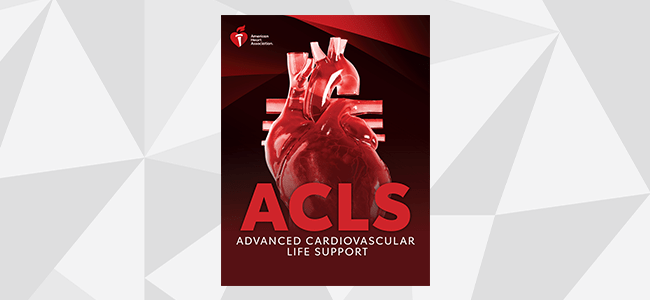Advanced Cardiovascular Life Support
(ACLS) Provider Course
The AHA's Advanced Cardiovascular Life Support (ACLS) provider course builds on the foundation of lifesaving Basic Life Support (BLS) skills, emphasizing the importance of continuous, high-quality CPR. The hands-on instruction and simulated cases in this advanced course are designed to help enhance skills in the recognition and intervention for adult cardiac arrest, stroke, and other cardiopulmonary emergencies through early recognition and time-sensitive intervention by high-performance teams. The AHA's ACLS course has been updated to reflect science and education from the American Heart Association 2025 Guidelines for Cardiopulmonary Resuscitation and Emergency Cardiovascular Care.
This is the International version of the ACLS Course. The training materials have been adapted to include metric units of measure and other references that apply to students outside the U.S. and Canada.

Supported Languages
國際英語
Formats Available
- Instructor-led training (ILT)
- Blended learning – HeartCode® ACLS + hands-on skills session training
- Resuscitation Quality Improvement® (RQI®)
- Apply the basic life support (BLS), primary, and secondary assessments sequence for a systematic evaluation of adult patients
- Discuss how the use of a rapid response team (RRT) or medical emergency team (MET) may improve patient outcomes
- Discuss early recognition and management of ACS, including appropriate disposition
- Discuss early recognition and management of stroke, including appropriate disposition
- Recognize bradycardias and tachycardias that may result in cardiac arrest or complicate resuscitation outcome
- Perform early management of bradycardias and tachycardias that may result in cardiac arrest or complicate resuscitation outcome
- Model effective communication as a member or leader of a high-performance team
- Recognize the impact of team dynamics on overall team performance
- Recognize respiratory arrest
- Perform early management of respiratory arrest
- Recognize cardiac arrest
- Perform prompt, high-quality BLS, including prioritizing early chest compressions, ventilation, and integrating early automated external defibrillator (AED) use
- Perform optimized management of cardiac arrest until termination of resuscitation or transfer of care, including post–cardiac arrest care
- Evaluate resuscitative efforts during a cardiac arrest through continuous assessment of cardiopulmonary resuscitation (CPR) quality, monitoring the patient’s response, and delivering real-time feedback to the team